7 Simple Ways to Use Competitive Intelligence In Your Marketing Strategy
Using competitive intelligence to fine-tune your marketing strategy, you'll find the game-changing tactics your competitors use, and adapt them for...
From forecasting trends, understanding audience affinities, and building last brand awareness—competitive intelligence is the MVP in your sales toolkit. But how can you make the case (and get the budget approved) by your executive team?
.png)
“We need to ramp up our competitive intelligence program."
But it’s difficult to communicate the return-on-investment (ROI) in numbers, so budget discussions go nowhere, and the initiative goes back to the bottom of your (very long) to-do list.
“We just lost a huge deal to a competitor when a new feature release took us by surprise. We need to prevent that happening again.”
But we can't settle on exactly HOW we'll do that, and no one seems ready to invest time or money to make it happen.
Sound familiar?
In the realm of product marketing and marketing in general, staying on top of market trends and competitor activity is crucial if you want to leapfrog the competition.
But tracking competitors can be costly both in terms of money and time. Competitive intelligence automation can quickly pay for itself in terms of time saving and depth of coverage.
But how can you effectively explain competitive intelligence software ROI and get the buy-in you need for your team? We’ll explore these ideas in concrete terms, using real-life examples and value-based messaging that can spark excitement for (and investment in) competitive intelligence software.
Competitive intelligence automation software helps businesses gather, filter, and analyze data about their competitors. That might include:
Through automation, businesses can gain a better understanding of their competition and make informed decisions to stay ahead—all in about an hour a week.
Competitive intelligence gives you the keys to analyze strengths and weaknesses—and use that information to your advantage. This can help you differentiate your products or services and stand out in a busy market.
For example, if “Competitor A” is known for its excellent customer service, you’d use that detail to improve your own customer service, offer proof of the improvement in the form of customer comments and reviews, and potentially attract more customers.
Or, if “Competitor B” is offering a similar product at a lower price, you might adjust your pricing strategy to stay competitive.
Having accurate and up-to-date information is crucial for making informed decisions. After all, consumer preferences, new competitor features, or product pricing can change overnight. These opportunities can either be a huge win or a huge loss for your entire team, depending on your awareness.
For instance, if you’re prepping a product launch, you can use competitive intelligence software to gather data on similar products in the market. This will help you determine the demand for your product, identify potential gaps, and adjust your positioning, messaging, and strategy accordingly.
Let’s say Competitor C focuses on the time-saving benefit of their release. If you know your audience is actually more interested in the product’s ease of use and ability to solve the problem of disorganized customer data, you can adjust your messaging to stand out.
How does automation help with that? When your systems alerts you to social posts and competitor reviews (and your own customer reviews), you never miss an opportunity to hear what people like and dislike, how the product lives up to expectations (or not), and what they were hoping to do with it. While you can always do a deep dive into all reviews, absorbing a steady stream of real-time feedback helps you always keep that customer and their needs in mind.
Competitive intelligence software not only provides data on your competitors but also on industry trends. By monitoring your competitors’ marketing strategies, product launches, and the reaction from the market, you can gain insights into the latest trends in your industry. This can help you stay ahead of the curve and adapt your business strategy accordingly.
For example, if you notice that your competitors are investing heavily in content centered around a new topic, you might assume a new product is coming or that they determined this topic is important to customers of their existing product. Is this something your product team should consider? Or is this a subject your marketing team might want to cover?
Rather than manually checking back daily or weekly, a tool such as EyeOn alerts you immediately when a competitor launches a new landing page, promotion, or positioning effort.
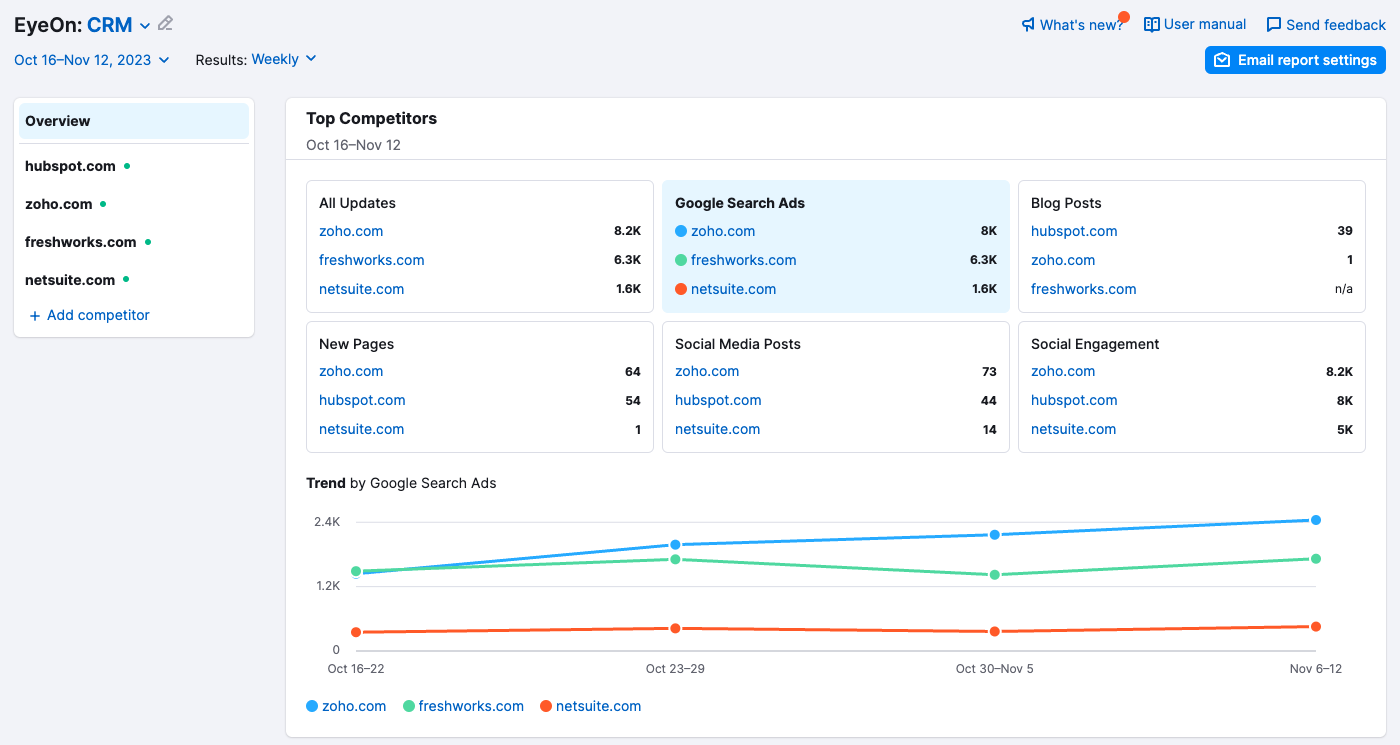
If you want to make a mark in your industry, simply being aware of current trends and competitor initiatives isn’t enough. Competitive intelligence software can help you spot emerging trends and potential disruptors in your market. This can lead to the development of new products or services that can give your business a competitive advantage.
For instance, keep an eye on the partnerships or acquisitions competitors are making. These can indicate areas where they see potential growth, which might also be opportunities for your company.

Kompyte spotted the acquisition of Clearbit by HubSpot, which signals investment into providing deep insights into customer behaviors and preferences.
Now that we’ve covered the general benefits of using competitive intelligence software, let’s dive into how it can specifically benefit your business.
Competitive intelligence software automates the process of gathering and analyzing data. This means businesses become more efficient with their most precious resources: time and money.
Let’s imagine your executive team decides to hire a full-time analyst dedicated to competitive research. Rather than one person spending up to 40 hours per week on these initiatives (and you paying their salary), you can use platforms such as Kompyte and .Trends from Semrush to dive into market insights and easily share findings with the whole team.
It’s easy to imagine a product marketing manager being overwhelmed with conducting competitive research on top of all their other responsibilities. Instead, a feature like the Daily AI Summaries works to track and filter the most important competitor activities in a daily email digest. This allows your team to focus on other important tasks, leading to increased productivity.
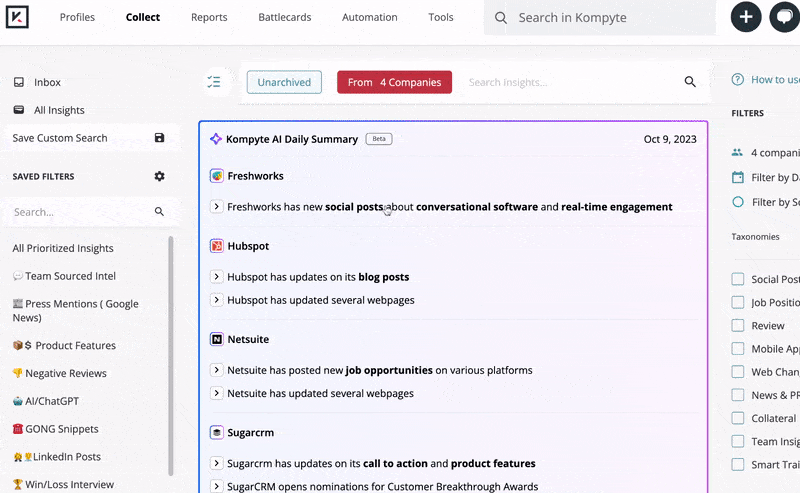
Making informed decisions that impact your entire organization can be intimidating, but less so when you have 24/7 access to real-time market data and insights.
Automation in competitive intelligence can help your entire organization make faster, more responsive decisions—from C-suite throughout members of your salesforce.
Let’s imagine your newest salesperson is on their first big call with a prospect. The customer says they’ve decided to go with another company because they just released a hot new AI-powered feature and dropped their subscription fee by 20% for the year.
Unable to respond or make a more convincing offer, your salesperson loses the deal, completely unaware of (and unprepared for) this change. It’s a big loss.
But when you use Kompyte’s Battlecard Templates, you’ll have an up-to-date guide for winning in such situations. In just a few clicks, you get a blueprint for handling objections, a full feature comparison chart, strengths and weaknesses—and a custom ChatGPT prompt to help guide your call. Even better, the Kompyte platform automates collection, filtering, and sharing of competitive insights in real time.
When you use Kompyte competitive intelligence automation, you can make those Battlecards available in the sales tools your team already uses. Because you know the last thing they want to do is open yet another application! And your Battlecards will always be up to date. Adding new insights in one field updates every Battlecard and report so you never have to wonder if everyone is getting the latest information.
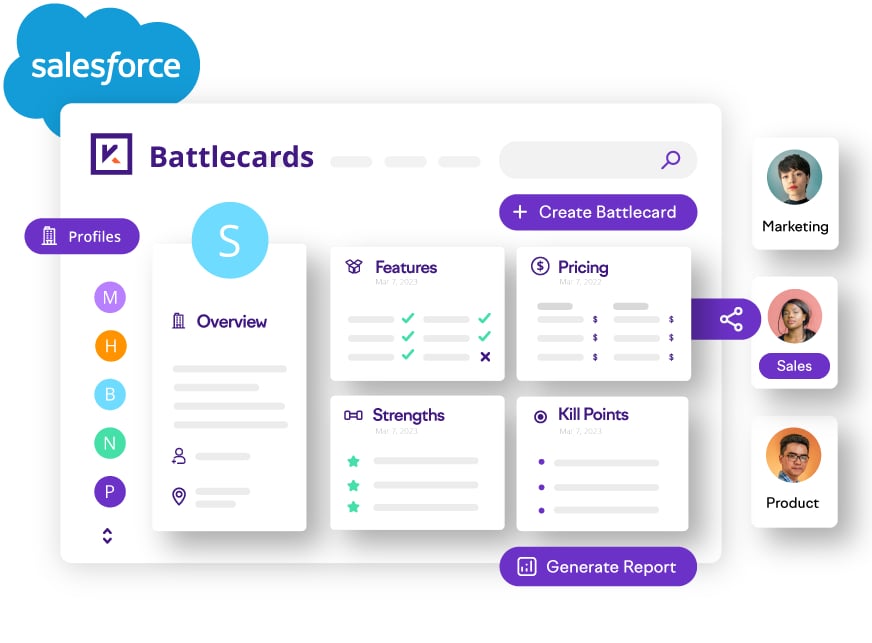
Better competitive intel translates into opportunities for your brand to shape your product offering and budgets to resonate with your target audience.
Audience analysis is a loaded initiative. It takes a great deal of time and digital expertise, audience surveys, and an analyst to interpret those data points into actionable results.
And your customers are complex—they aren’t one-dimensional. You need segmentation within that so you can craft tailored offerings and messages that land within those audience segments.
With a tool such as One2Target, you can access insights into your competitors’ customer base (such as their demographic information, income level, traffic journey, even their preferred social media platforms) to plan your next impactful sales campaign.
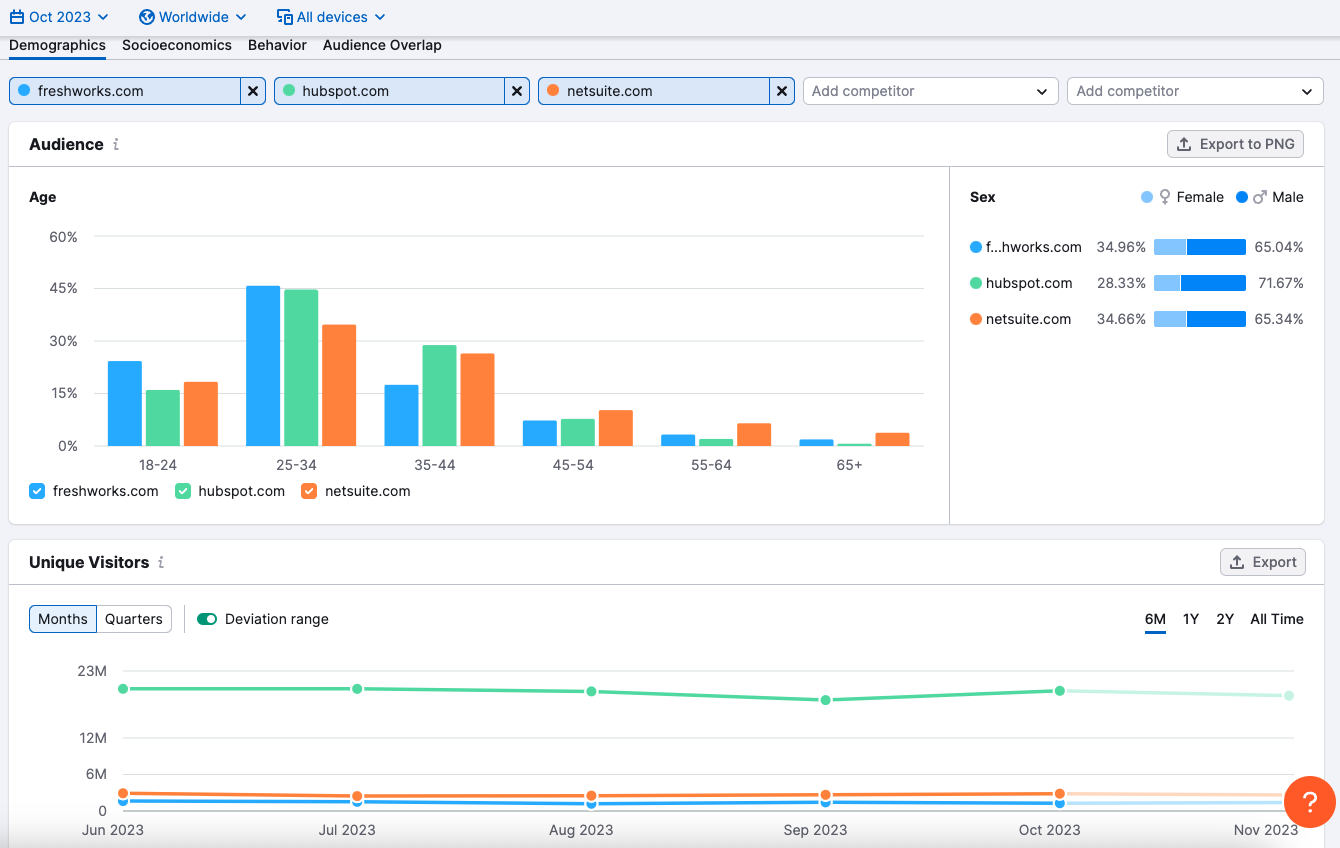
Competitive pricing is a crucial aspect of any business, but it shouldn’t be your only differentiator.
By analyzing the pricing strategies within your market, you can determine the optimal price for your products or services. This can help you stay competitive while also maximizing profits.
By making it easy for your sales team to send intel on the go, you get more shared knowledge which makes everyone better at selling, marketing, and developing!
For example, your sales representative is on a call with a prospect when he learns that your biggest competitor offered them a huge discount if they close the deal before the end of the quarter. Especially if this is unusual, your team needs to know! They can use the Kompyte extension from anywhere to send in a quick note which you can review and make available for all your teams.
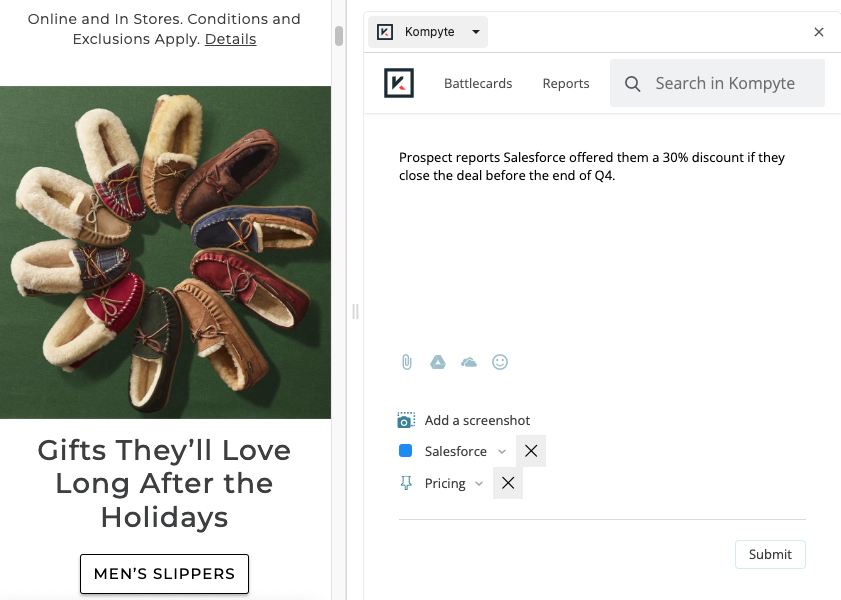
Anyone on the team can use the browser extension to send in a crucial competitor insight, no matter where they are online.
Now that we’ve established the thematic benefits of automated competitive intelligence software, it’s time to consider how you’d explain these in terms of getting buy-in from your team.
Every company, and every team, has its individual culture and set of values. Use these three tips as a guideline for making your case for competitive intelligence software.
Remember the analysis paralysis we mentioned earlier?
The whole point of investing in competitive intelligence software is to make life easier. Design your pitch in a way that demonstrates the robustness of competitive data without overwhelming your team or executives.
Consider implementing different formats that are user-friendly and straightforward, like a weekly Competitor Digest or newsletter. Having them sent at regular intervals can keep your organization on the same page, allowing for ongoing review and discussion. Send people only what they need.
Above all else, keep your updates short, focused, and easy to read.
Revenue and growth are key performance indicators (KPIs) across the board, but consider how stakeholders within your company value deliverables.
To that end, you should provide different competitive intelligence updates for different teams.
Examples of tailored deliverables could be:
Both Kompyte and .Trends support automated reporting and sharing, allowing you to demonstrate success using the KPIs that matter the most to your stakeholders.
How do you bridge the gap between raw data and its value to your company?
Analysis paralysis returns. There’s no point in demonstrating dozens of data sheets to your CFO without having a plan to put those insights into action.
Consider this approach with your competitive intelligence initiatives.
Analyze each piece of intel and break it down into these five points:
If you can correlate each insight with a clear impact, you’ll increase the chances of company-wide adoption of competitive intelligence software.
For example, if you notice an uptick in negative competitor reviews mentioning customer service, your marketing team may want to create campaigns or assets showing off what people say about your superior service.
Sales teams may also highlight that in their calls, sharing your own positive customer service reviews.
And customer service teams should be informed so they know how important they are to keeping customers happy and outselling the competition. Knowing that they are a key differentiator can give them an extra level of pride in their work that makes your customer service even better.
With so many options available, it can be challenging to choose the right one for your brand.
You’ll want a solution that offers rich data that’s both understandable and actionable. There’s no point in confusing or overwhelming your team.
Here are additional factors to consider:
Many companies have achieved household name status, championing competitive pricing, consumer behaviors, and market trends to grow. While their actual competitive intelligence initiatives aren’t always publicly disclosed, here’s how it looks on the consumer end.
Recently, Netflix noticed rivals Disney+, Amazon Prime Video, and HBO Max gaining ground in over 100 countries. Their response? Lower subscription prices in those areas, adding a new "Netflix Lite" tier. (source)
Uber utilizes competitive intelligence by employing a dynamic pricing algorithm, adjusting rates based on variables such as route distance, time, traffic, and rider-to-driver demand.
This approach allows Uber to efficiently manage pricing during peak hours, big events, and festivals.
But, in order to ensure its fares remain competitive, attracting both riders and drivers, they also analyze competitor pricing strategies.
Real-time adjustments, sometimes called shifted-market pricing, enables the company to balance supply and demand, enhancing customer experience. Uber’s competitive intelligence practices empower the company to stay agile, optimize pricing strategies, and maintain a robust network of drivers.
The best example is the one that hits home.
If you have an example of a time when your company missed an important competitor update, resulting in serious business consequences, use that.
Otherwise, spend some doing manual competitive intelligence until you find a striking example.
Point out what you were able to do because you did find it, what could have resulted if you hadn't found it, share where you found it (and how much time it takes to monitor those sources). Remind them of how much time you have available to spend on competitive intelligence each week and why that means means there is likely much more you could have found but haven't.
Here are some ideas to get you started. If possible, choose one that would best tap into the concerns of the person with the budget!
| Team Impacted: | What you found: | Potential consequence had you missed it: | What you can do because you found it: | Where you found it: |
| Product | Competitor's reviews reveal a growing demand for customization options. | Misalignment with customer needs, leading to reduced satisfaction and loyalty and market share. | Adapt products or services to better meet customer needs, increasing loyalty and market share. | Customer review sites, social media |
| Sales & Marketing | A competitor partners with a major online platform, significantly increasing their market access. | Reduced market presence and sales if competitors exploit more effective channels. | Expand or optimize distribution channels to increase market reach and sales. | Industry news, competitor press releases, business partnership announcements, competitor blog and website. |
| Marketing | A competitor's successful social media campaign highlights a shift towards sustainability that resonates with your shared audience | Ineffective marketing campaigns due to outdated approaches or misalignment with current market sentiments. | Tailor marketing campaigns to resonate more with current consumer preferences, increasing engagement and conversions. | Social media, marketing industry publications, competitor advertising campaigns. |
With competitive intelligence software, brands can gain valuable insights and data on their competitors, make better decisions, and stay ahead of industry trends.
With the right software, businesses can improve their decision-making, increase efficiency, and identify new opportunities. Consider implementing competitive intelligence software in your business to gain a competitive advantage and drive success.
Give your whole organization—from executive management to your salesforce—the tools to increase revenue with Kompyte. Book a demo today.
Using competitive intelligence to fine-tune your marketing strategy, you'll find the game-changing tactics your competitors use, and adapt them for...
3 Underused, Highly Effective, Ways to Use Competitive Intelligence. See how you can learn from your competitor's mistakes, use real-time data to...
When most people think of competitive enablement, they automatically think of sales. But, they're not the only ones that can benefit from CI. Teams...
Be the first to know about new B2B SaaS Marketing insights to build or refine your marketing function with the tools and knowledge of today’s industry.